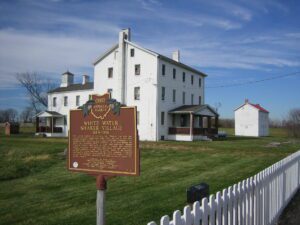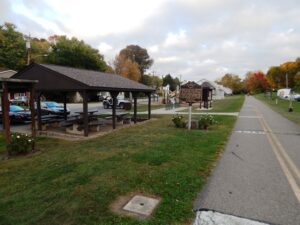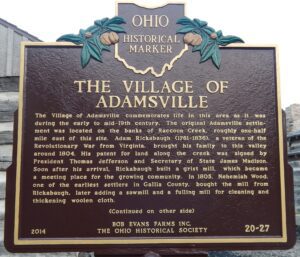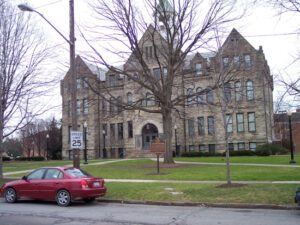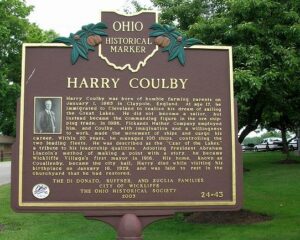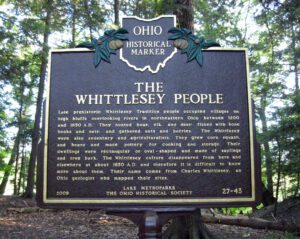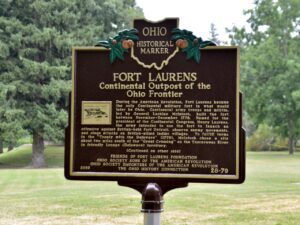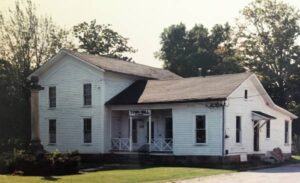, OH
The United Society of Believers (or “Shakers,” as they are commonly known) established White Water, the last of four Ohio Shaker villages, in 1824. White Water flourished throughout the nineteenth and early twentieth centuries. At its peak during the 1850s, 150 Believers living in three semi-autonomous Shaker “families” farmed 1,300 acres of land in Crosby and adjacent Morgan townships. The Shakers were among the most successful religious societies in the United States. Belief in the equality of men and women, separation of the sexes, celibacy, communal ownership of property, and a distinctive style of worship — characterized by rhythmic movements and shaking — helped define the Shaker lifestyle. (Continued on other side)
, OH
Deerfield was laid out around 1795 and in 1802 Major Benjamin Stites, his son Benjamin, Jr., and John Gano officially recorded the village’s plat. A part of the great tide of Americans moving into the Northwest Territory (and Ohio after 1803), Deerfield’s early inhabitants included Revolutionary war veteran Ephraim Kibbey as well as Andrew Lytle, Nathan Kelly, William Snook, and War of 1812 veteran David Sutton. Deerfield was so called because it was a settlement in Deerfield Township, Hamilton County in the 1790s. (Continued on other side)
, OH
The Village of Adamsville commemorates life in this area as it was during the early to mid-19th century. The original Adamsville settlement was located on the banks of Raccoon Creek, roughly one-half mile east of this site. Adam Rickabaugh (1761-1836), a veteran of the Revolutionary War from Virginia, brought his family to this valley around 1804. His patent for land along the creek was signed by President Thomas Jefferson and Secretary of State James Madison. Soon after his arrival, Rickabaugh built a grist mill, which became a meeting place for the growing community. In 1805, Nehemiah Wood, one of the earliest settlers in Gallia County, bought the mill from Rickabaugh, later adding a sawmill and a fulling mill for cleaning and thickening woolen cloth. (Continued on other side)
, OH
On this site the Lyceum Village and the Berea Seminary were established in 1837 by John Baldwin, James Gilruth, Henry O. Sheldon, and Josiah Holbrook. Their vision was to create the first in a connected series of Lyceum Villages. The Villages were designed especially to assist in the education of teachers, promote “scientific” exchanges over the world and thus encourage the study of the works and word of God, and cultivate the spirit of “peace on earth and good will to men.” The community, however, declined and in 1842, John Baldwin assumed the indebtedness of $15,000. James Wallace acquired the area. It was owned by the Methodist Children’s Home in the 1860s and then sold to German Wallace College in 1866, becoming the original German Wallace College campus.
, OH
Harry Coulby was born of humble farming parents on January 1, 1865 in Claypole, England. At age 17, he immigrated to Cleveland to realize his dream of sailing the Great Lakes. He did not become a sailor, but instead became the commanding figure in the ore shipping trade. In 1886, Pickands Mather Company employed him, and Coulby, with imagination and a willingness to work, made the movement of ships and cargo his career. Within 20 years, he managed 100 ships, controlling the two leading fleets. He was described as the “Czar of the Lakes,” a tribute to his leadership qualities. Adopting President Abraham Lincoln’s method of making a point with a story, he became Wickliffe Village’s first mayor in 1916. His home, known as Couallenby, became the city hall. Harry died while visiting his birthplace on January 18, 1929, and was laid to rest in the churchyard that he had restored.
, OH
The Indian Point Site contains the remains of a prehistoric Native American earthen enclosure, officially known as the Lyman site, named after a former property owner. The site contains two earthen walls that are bordered by ditches. Steep cliffs provide natural barriers on two sides of the enclosure. Archaeological digs have uncovered many artifacts here, including pottery sherds, tools, pipes, and beads. There is evidence that the walls were built around 140 B.C., and the site was occupied again around 1500 A.D. by the Whittlesey Tradition people. It is uncertain if the site was a village or was used as a ceremonial center. After 1650 A.D., the area became a neutral hunting ground for various historic tribes.
, OH
During the American Revolution, Fort Laurens became the only Continental military fort in what would later be Ohio. Continental army troops and militia, led by General Lachlan McIntosh, built the fort between November-December 1778. Named for the president of the Continental Congress, Henry Laurens, the army intended to use the fort to launch an offensive against British-held Fort Detroit, observe enemy movements, and stage attacks on British-allied Indian villages. To fulfill terms in the “Treaty with the Delaware” (1778), McIntosh chose a site about two miles south of the “Great Crossing” on the Tuscarawas River in friendly Lenape (Delaware) territory. (Continued on other side)
, OH
The Village of South Amherst incorporated in 1918. Mayor Fred Ruth and village’s council authorized a special election on February 22, 1919 so that the village could issue bonds to establish a town hall. The village used the funds to buy the house of Jeannette and Alexander Born. Purchased on September 3, 1919 for $3,750, the home-turned town hall served the village for 70 years. As the community grew and the building aged, the need for a new facility became clear. The old town hall was demolished and construction of a spacious $274,000 building begun in September 1988. The village’s government moved into its new 3,200 square-foot hall in February 1989.


